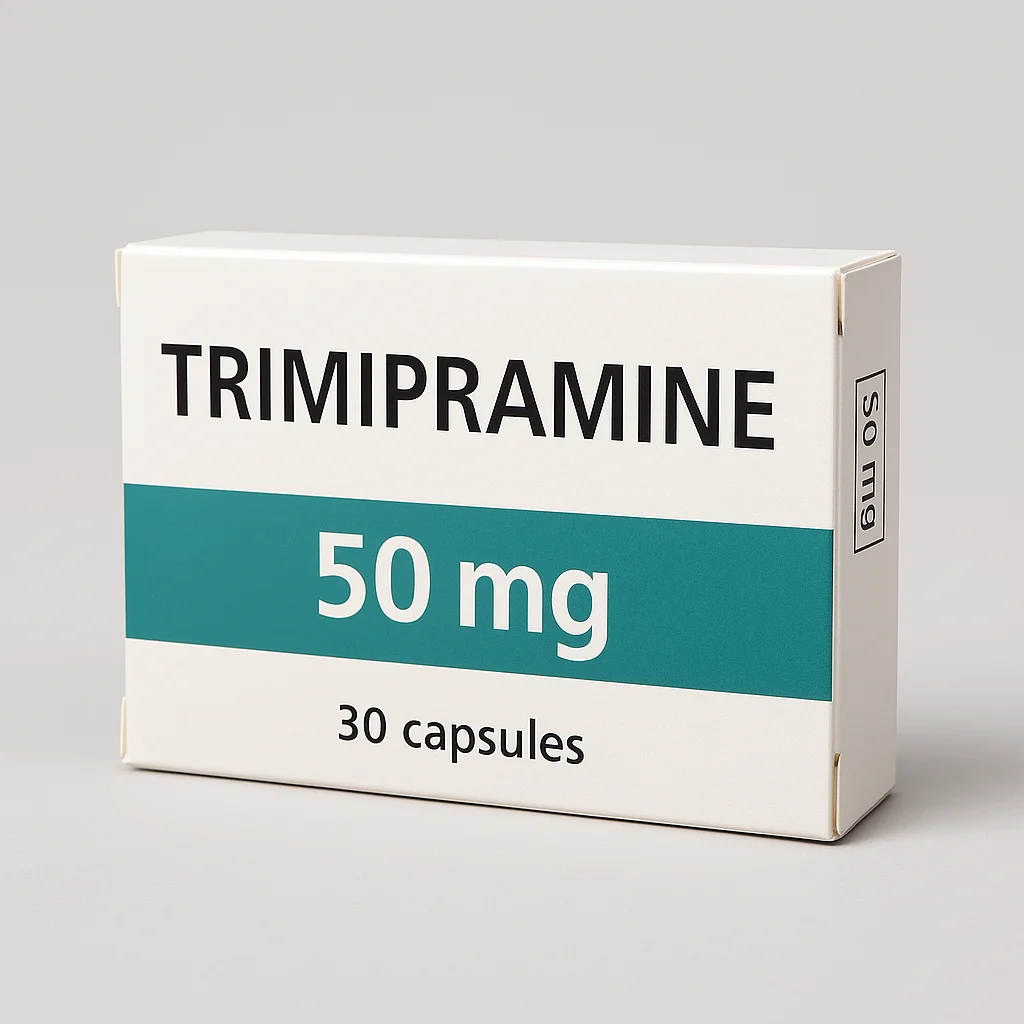Free UK shipping
Results in under 14 days
UK lab
10% Off All Tests - Autumn 2025
Introduction to Trimipramine
Trimipramine is sometimes called an “atypical” TCA (tricyclic antidepressant) because, unlike most other TCAs, it works less by blocking serotonin reuptake and more by blocking specific serotonin receptors. In fact, it blocks the 5-HT2 receptor to a similar degree as the antipsychotic clozapine (32).
Like other TCAs, it was introduced in the 1950s (27). Although effective, it is not usually a first-line antidepressant today, because newer drugs such as SSRIs (e.g., fluoxetine, citalopram) are better tolerated and have fewer side effects (9).
Trimipramine is highly sedating, making it useful for patients with depression who also struggle with anxiety or insomnia. Interestingly, it has been shown to reduce cortisol (a stress hormone) and to increase REM sleep (dreaming phase), in contrast to most antidepressants, which suppress REM sleep (33).

Considerations for Patients Taking Trimipramine
Trimipramine is strongly sedating, similar to doxepin. While this can help with sleep problems, it also increases risks of falls, daytime drowsiness, and confusion, especially in older adults (34).
Pharmacology
-
Less potent at blocking serotonin reuptake than other TCAs.
-
Acts mainly through receptor blockade, earning it the label “atypical antidepressant” (32, 33).
-
Like other TCAs, it has emerging anti-inflammatory properties, under study for pain and other conditions (16, 1).
Anticholinergic Burden
Trimipramine contributes mild anticholinergic effects compared to drugs like amitriptyline. These can still affect brain function, leading to memory loss, confusion, or delirium, especially in older patients. Over time, this contributes to the anticholinergic burden—the combined load of medicines that interfere with acetylcholine, a key neurotransmitter for memory and attention (11, 12, 13).
Serotonin Syndrome
Although less potent as a serotonin reuptake inhibitor, trimipramine still raises serotonin levels. When combined with other serotonin-boosting medicines (SSRIs, MAO inhibitors, tramadol, opioids) or supplements (tryptophan, St John’s Wort), it can cause serotonin syndrome—a rapid, potentially life-threatening condition (17).
Prolonged QT Interval
Like other TCAs, trimipramine can prolong the QT interval (7). This is a change in the heart’s rhythm that can lead to arrhythmias. Risk is higher in older adults, women, and those with heart disease or electrolyte imbalances (15).
Overdose and Toxicity
Overdose is a recognised risk. Toxicity can appear even at the higher end of the normal therapeutic range. Symptoms are similar to other TCAs and may include convulsions, heart arrhythmias, coma, and low blood pressure (35).
Trimipramine vs Other TCAs
-
Sedation: Very strong, similar to doxepin.
-
Anticholinergic burden: Milder than amitriptyline, but not negligible.
-
Unique profile: “Outsider” in the TCA family due to antipsychotic-like receptor activity (32, 33, 34).
Why Have I Been Prescribed Trimipramine?
Treating depression where sedation is useful
According to the British National Formulary (BNF), trimipramine is licensed for the treatment of depression, particularly where sedation is desirable (18).
Trimipramine Doses
How and when to take it
-
Adults: Start with 50–75 mg daily in divided doses, or 50–75 mg once daily at bedtime. If needed, gradually increase to 150–300 mg daily.
-
Older adults: Start with 10–25 mg three times daily, with maintenance doses of 75–150 mg daily.
Trimipramine Side Effects
Like other TCAs, trimipramine can cause side effects, though their intensity varies. Compared with amitriptyline, it usually has a lower anticholinergic burden, but it is still very sedating, which increases risks for older adults.
Most Common Side Effects
-
Weight gain
-
Constipation
-
Dry mouth
-
Dizziness
-
Headache
-
Drowsiness (somnolence)
Alpha-Adrenergic Blockade (less pronounced than other TCAs)
-
Low blood pressure when standing (orthostatic hypotension)
-
Dizziness
-
Sedation
Anticholinergic Effects (milder than other TCAs)
-
Blurred vision
-
Dry mouth
-
Difficulty passing urine (urinary retention)
-
Fast heart rate (tachycardia)
-
Confusion or delirium
Histamine Blockade (very strong)
-
Marked sedation
-
Increased appetite
-
Weight gain
-
Confusion or delirium
Other Reported Effects
-
Suicidal thoughts or ideation
-
Increased risk of seizures
-
Abnormal liver function
How Your Body and Genes Process Trimipramine
How your body processes trimipramine—and how your genes affect this—can influence both effectiveness and side effects.
 Metabolism
Metabolism
Trimipramine is metabolised in two main steps (19):
-
CYP2C19: Converts trimipramine into desmethyltrimipramine, an active metabolite.
-
CYP2D6: Further breaks down trimipramine and its metabolite into inactive compounds.
Personalising Trimipramine with Pharmacogenetics
Genetic differences in CYP2C19 and CYP2D6 can affect treatment:
-
Poor metabolisers: Higher drug levels → more side effects (e.g., dizziness, drowsiness, heart rhythm changes). Start at 50% of the usual dose with close monitoring.
-
Ultrarapid metabolisers: Break the drug down too quickly → reduced benefit. A different antidepressant may be needed.
-
Normal metabolisers: Standard dosing applies, adjusted to individual response.
While pharmacogenomic testing for trimipramine is not yet routine, it may help identify patients at risk of poor tolerance or lack of response.
Related Medications:
Other TCAs with similar pharmacogenetic considerations:
Explore PGx for Mental HealthReferences
(1) https://www.mdpi.com/1424-8247/18/2/197 (2) https://www.frontiersin.org/journals/neurology/articles/10.3389/fneur.2017.00307/full (3) https://www.mdpi.com/2227-9059/5/2/24 (4) https://pmc.ncbi.nlm.nih.gov/articles/PMC2014120/ (5) https://www.nature.com/articles/s41392-024-01738-y (6) https://systematicreviewsjournal.biomedcentral.com/articles/10.1186/s13643-020-01296-8 (7) https://pmc.ncbi.nlm.nih.gov/articles/PMC5972123/ (8) https://www.ncbi.nlm.nih.gov/books/NBK537225/ (9) https://www.ncbi.nlm.nih.gov/books/NBK557791/ (10) https://pmc.ncbi.nlm.nih.gov/articles/PMC9427617/ (11) https://journals.sagepub.com/doi/10.1177/20451253231195264 (12) https://www.frontiersin.org/journals/neuroscience/articles/10.3389/fnins.2019.01309/full (13) https://onlinelibrary.wiley.com/doi/10.1111/jnc.15244 (14) https://bpspubs.onlinelibrary.wiley.com/doi/10.1111/bcp.15261 (15) https://pmc.ncbi.nlm.nih.gov/articles/PMC4110870/ (16) https://www.frontiersin.org/journals/cell-and-developmental-biology/articles/10.3389/fcell.2023.1072629/full (17) https://pmc.ncbi.nlm.nih.gov/articles/PMC6539562/ (18) https://www.nice.org.uk/about/what-we-do/evidence-and-best-practice-resources/british-national-formulary--bn (19) https://pmc.ncbi.nlm.nih.gov/articles/PMC5478479/ (20) https://www.ncbi.nlm.nih.gov/books/NBK482214/ (21) https://pmc.ncbi.nlm.nih.gov/articles/PMC6493872/ (22) https://pmc.ncbi.nlm.nih.gov/articles/PMC9048453/?utm_source=chatgpt.com (23) https://pubmed.ncbi.nlm.nih.gov/7395525/ (24) https://pmc.ncbi.nlm.nih.gov/articles/PMC11141239/ (25) https://pubmed.ncbi.nlm.nih.gov/9537821/ (26) https://www.ncbi.nlm.nih.gov/books/NBK541006/ (27) https://www.ncbi.nlm.nih.gov/books/NBK557656/ (28) https://www.researchgate.net/publication/372475601_Therapeutic_drug_monitoring_of_imipramine_correlation_with_a_case_study (29) https://www.ncbi.nlm.nih.gov/books/NBK542306/ (30) https://pmc.ncbi.nlm.nih.gov/articles/PMC4027305/ (31) https://pubmed.ncbi.nlm.nih.gov/39202/ (32) https://www.sciencedirect.com/science/article/abs/pii/002839089190160D (33) https://link.springer.com/article/10.1007/BF02190274 (34) https://pubmed.ncbi.nlm.nih.gov/2693055/ (35) https://pmc.ncbi.nlm.nih.gov/articles/PMC3555062/